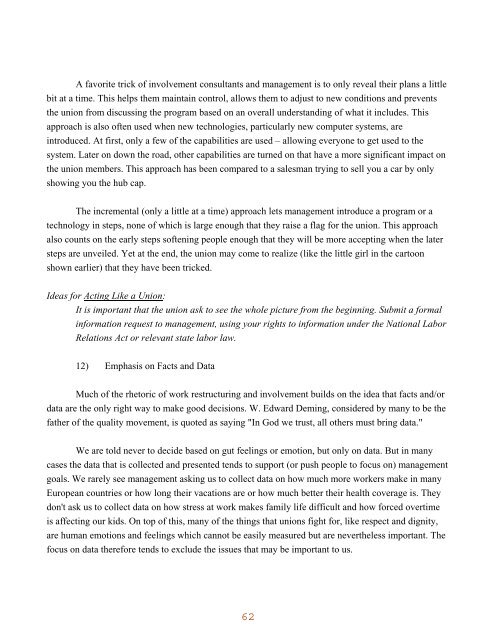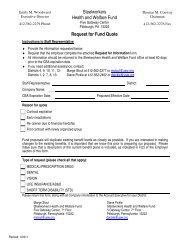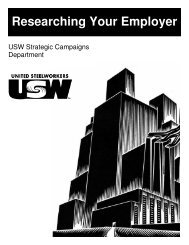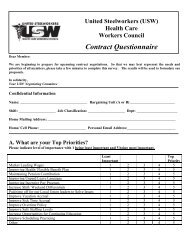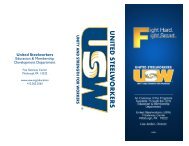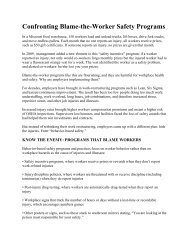Union Approach to Health and Safety: - United Steelworkers
Union Approach to Health and Safety: - United Steelworkers
Union Approach to Health and Safety: - United Steelworkers
Create successful ePaper yourself
Turn your PDF publications into a flip-book with our unique Google optimized e-Paper software.
A favorite trick of involvement consultants <strong>and</strong> management is <strong>to</strong> only reveal their plans a little<br />
bit at a time. This helps them maintain control, allows them <strong>to</strong> adjust <strong>to</strong> new conditions <strong>and</strong> prevents<br />
the union from discussing the program based on an overall underst<strong>and</strong>ing of what it includes. This<br />
approach is also often used when new technologies, particularly new computer systems, are<br />
introduced. At first, only a few of the capabilities are used – allowing everyone <strong>to</strong> get used <strong>to</strong> the<br />
system. Later on down the road, other capabilities are turned on that have a more significant impact on<br />
the union members. This approach has been compared <strong>to</strong> a salesman trying <strong>to</strong> sell you a car by only<br />
showing you the hub cap.<br />
The incremental (only a little at a time) approach lets management introduce a program or a<br />
technology in steps, none of which is large enough that they raise a flag for the union. This approach<br />
also counts on the early steps softening people enough that they will be more accepting when the later<br />
steps are unveiled. Yet at the end, the union may come <strong>to</strong> realize (like the little girl in the car<strong>to</strong>on<br />
shown earlier) that they have been tricked.<br />
Ideas for Acting Like a <strong>Union</strong>:<br />
It is important that the union ask <strong>to</strong> see the whole picture from the beginning. Submit a formal<br />
information request <strong>to</strong> management, using your rights <strong>to</strong> information under the National Labor<br />
Relations Act or relevant state labor law.<br />
12) Emphasis on Facts <strong>and</strong> Data<br />
Much of the rhe<strong>to</strong>ric of work restructuring <strong>and</strong> involvement builds on the idea that facts <strong>and</strong>/or<br />
data are the only right way <strong>to</strong> make good decisions. W. Edward Deming, considered by many <strong>to</strong> be the<br />
father of the quality movement, is quoted as saying "In God we trust, all others must bring data."<br />
We are <strong>to</strong>ld never <strong>to</strong> decide based on gut feelings or emotion, but only on data. But in many<br />
cases the data that is collected <strong>and</strong> presented tends <strong>to</strong> support (or push people <strong>to</strong> focus on) management<br />
goals. We rarely see management asking us <strong>to</strong> collect data on how much more workers make in many<br />
European countries or how long their vacations are or how much better their health coverage is. They<br />
don't ask us <strong>to</strong> collect data on how stress at work makes family life difficult <strong>and</strong> how forced overtime<br />
is affecting our kids. On <strong>to</strong>p of this, many of the things that unions fight for, like respect <strong>and</strong> dignity,<br />
are human emotions <strong>and</strong> feelings which cannot be easily measured but are nevertheless important. The<br />
focus on data therefore tends <strong>to</strong> exclude the issues that may be important <strong>to</strong> us.


